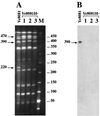The high-pathogenicity island of Yersinia enterocolitica Ye8081 undergoes low-frequency deletion but not precise excision, suggesting recent stabilization in the genome
- PMID: 10496882
- PMCID: PMC96857
- DOI: 10.1128/IAI.67.10.5091-5099.1999
The high-pathogenicity island of Yersinia enterocolitica Ye8081 undergoes low-frequency deletion but not precise excision, suggesting recent stabilization in the genome
Abstract
Highly pathogenic strains of Yersinia pestis, Y. pseudotuberculosis, and Y. enterocolitica are characterized by the possession of a pathogenicity island designated the high-pathogenicity island (HPI). This 35- to 45-kb island carries an iron uptake system named the yersiniabactin locus. While the HPIs of Y. pestis and Y. pseudotuberculosis are subject to high-frequency spontaneous deletion from the chromosome, we were initially unable to obtain HPI-deleted Y. enterocolitica 1B isolates. In the present study, using a positive selection strategy, we identified three HPI-deleted mutants of Y. enterocolitica strain Ye8081. In these three independent clones, the chromosomal deletion was not limited to the HPI but encompassed a larger DNA fragment of approximately 140 kb. Loss of this fragment, which occurred at a frequency of approximately 5 x 10(-7), resulted in the disappearance of several phenotypic traits, such as growth in a minimal medium, hydrolysis of o-nitrophenyl-beta-D-thiogalactopyranoside, Tween esterase activity, and motility, and in a decreased virulence for mice. However, no precise excision of the Ye8081 HPI was observed. To gain more insight into the molecular basis for this phenomenon, the putative machinery of HPI excision in Y. enterocolitica was analyzed and compared to that in Y. pseudotuberculosis. We show that the probable reasons for failure of precise excision of the HPI of Y. enterocolitica Ye8081 are (i) the interruption of the P4-like integrase gene located close to its right-hand boundary by a premature stop codon and (ii) lack of conservation of 17-bp att-like sequences at both extremities of the HPI. These mutations may represent a process of HPI stabilization in the species Y. enterocolitica.
Figures




References
-
- Altschul S F, Gish W, Miller W, Myers E W, Lipman D J. Basic local alignment search tool. J Mol Biol. 1990;215:403–410. - PubMed
-
- Bercovier H, Mollaret H H. Genus XIV: Yersinia Van Loghem 1944, 15AL. In: Krieg N R, Holt J G, editors. Bergey’s manual of systematic bacteriology. Vol. 1. Baltimore, Md: Williams & Wilkins; 1984. pp. 498–506.
-
- Blattner F R, Plunkett III G, Bloch C A, Perna N T, Burland V, Riley M, Collado-Vides J, Glasner J D, Rode C K, Mayhew G F, Gregor J, Davis N W, Kirkpatrick H A, Goeden M A, Rose D J, Mau B, Shao Y. The complete genome sequence of Escherichia coli K-12. Science. 1997;277:1453–1474. - PubMed
Publication types
MeSH terms
Substances
Associated data
- Actions
- Actions
LinkOut - more resources
Full Text Sources

